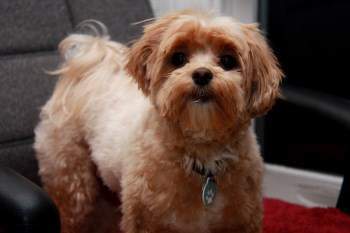Maltipoo Ears
Overview
In this section we are going to talk all about Maltipoo ears.
There are 3 main elements that we will discuss:
1) Shape and Size - Most importantly, we will talk about erect vs drop ears, since so many readers ask questions about this and what shaped ear a Maltipoo should have.
2) Cleaning and Upkeep of the Ears - This is an important, but often overlooked, element of grooming
3) Ear Infections - This is a common problem with Maltipoos. While it can happen to any dog at any time, the ear shape and thickness can contribute to this, as well as a lack of timely ear cleanings.
Please note:
PetMaltipoo is reader-supported. Some of the product suggestions on this page are affiliate links. As an Amazon Associate we earn from qualifying purchases. This is at no extra cost to you and helps us continue creating useful content.
Ear Size and Shape
To know what shape and size Maltipoo ears should be, we must look to the Toy Poodle and the Maltese. Poodles have thicker, longer leathers but both have drop ears that hang close to the sides of the head. Both are set low - this means that the base is not located high atop the head, but rather down to the sides.
In addition, both have long hairs that grow in what is described as feathered appearance (hairs will be of varying length). Once hairs hanging down from the ears become long, many owners choose these trimmed to offer a nice, neat appearance.
A Maltipoo, having genes from both breeds, may lean toward either, and therefore some Maltipoo dogs will have smaller, thinner ears than others.
The expected length of ears on a Maltipoo will be anywhere from the cheekbone to the chin. Long hairs hanging down can often make the ears appear a bit longer than they actually are.
Dropped vs Erect
Both Poodles and Maltese have drop ears and therefore so do Maltipoo dogs. Questions can arise when a puppy appears to have erect ears. This is actually quite common (although they are not really fully erect) and this is because Maltese puppies often have curled, folded ears; as the pup matures, the ears drop down into place. The first 1/4 to 1/2 inch of the base will be erect and then the ear will fold over and fall against the side of the face.
Therefore, Maltipoo puppies that have ears influenced by the Maltese genes, may have small, curled over ears. In time, they will fold over and drop down. They should not ever be fully erect, however - if a Maltipoo has full, erect stand-up ears this points to poor breeding practices and the dog may not be a true Maltipoo.
Ear Anatomy
There are 3 main sections of the ear:
1. The pinna. This is the “ear flap” which is the outside part of the ear that you see and also includes the outer ear canal.
2. The middle ear. In this part of the dog’s ear is what is called the tympanic membrane, the auditory canal (which connects the nose and throat just as with humans) and the tympanic cavity.
3. The internal ear. In this part are elements which allow the dog to have equilibrium (a sense of balance, no dizziness, etc.) and for hearing.
The ear canal itself goes all the way from the opening that you see in the external ear all the way down to the tympanic membrane in the middle part of the ear.
Cleaning a Maltipoo's Ears
Overview:
Rosie, 4 years old
Dogs that have drop ears are more prone to ear infection since the ear flap keeps both warmth and moisture trapped in the ear canal. Cleaning your Maltipoo's ears will be an important step in grooming
and will help to prevent infection.
If your Maltipoo has had a lot of ear infections in the past, most likely you will be more proactive in preventing them, so you may be preparing to start performing regular cleanings. And, if your Maltipoo currently has an ear infection, cleaning the ears is often part of the treatment for this.
Cleaning the ears will mean using a rinse to clear out debris and excess wax. It may also include plucking out any excessively long hairs.
Inspecting the ears:
It's a good idea to regularly inspect the ears for signs of issues. Since this type of task can easily be forgotten, it can help to do this each time you are bathing your Maltipoo, which is typically every 3 weeks.
First look at the skin color inside the ear and on the flaps. It should be pink. If you see patches of red, black, or brown, or pink skin with any other colored spot or dots, this can mean that there is an issue.
Now, it is time to take notice of any odors. A bad odor
is one of the first signs of infection; this may be a musty smell, and can be quite overpowering.
The last element that you want to inspect is the amount of wax that you can visibly see. A small amount of wax is normal and is needed. It helps to keep dust, dirt and other elements out of your Maltipoo’s ears. However, excess wax will need to be cleaned out.
How to pluck out long hairs:
Long hairs can grow from the ear canal, and if so, excess wax will often cling to these, blocking air flow. If a Maltipoo has issues with reoccurring ear infections, keeping the canals free of long hairs is often part of the treatment plan.
Plucking out ear hairs is easiest when using a hemostat and some ear powder.
For the hemostat, a stainless-steel curved one like the PetEdge Stainless Steel Curved 5-1/2-Inch Pet Hemostat
 can work rather well. Do be extremely careful, because if you insert a hemostat too far down or if your Maltipoo suddenly moves while you are working to grab the hairs, it can cause injury.
can work rather well. Do be extremely careful, because if you insert a hemostat too far down or if your Maltipoo suddenly moves while you are working to grab the hairs, it can cause injury.
Ear powder makes it much easier to grip hairs, and can help reduce some of the quick yet sharp pain as you pull them out.
You do not need to use a lot; just a bit will do. Most of these, like ProEar Professional Ear Powder , comes with a narrow nozzle at the top. You just gently place this into the ear canal and give the bottle a short squeeze. The fine powder will sprinkle down into the outer canal, and cling to the hairs.
, comes with a narrow nozzle at the top. You just gently place this into the ear canal and give the bottle a short squeeze. The fine powder will sprinkle down into the outer canal, and cling to the hairs.
Pluck out just a few hairs at a time. Do this fast (like ripping a Bandaid off, it is best to pull with confidence and quickly).
Once you are satisfied with the removal of excess, long hairs in the ears, use a cotton ball or a small piece of gauze with canine ear lotion applied to it, to clean away any debris, dirt, and/or wax from the ear flap and around the outer ear canal.
How to clean the ears with solution:
If you notice a lot of wax buildup, or as part of a regular grooming routine, cleaning the ears is relatively easy.
You will just need 2 things:
1. An ear cleaner solution
If you are just doing regular cleanings, a gentle, yet effective product like Vet Solution's Ear Cleansing Solution
 is best. This can be used as often as every day, and has aloe vera to keep inner ear skin healthy.
is best. This can be used as often as every day, and has aloe vera to keep inner ear skin healthy.
If your Maltipoo has ear issues, including lots of irritation due to allergies, or even mites or yeast, one like EcoEars Dog Ear Infection Formula
 can be helpful.
can be helpful.
2. Sterile cotton balls or sterile cotton gauze
You'll be swiping the outer ear canal, so you'll want the cotton balls or gauze to be appropriately sized, in accordance to the size of your Maltipoo. For puppies, a cotton ball may need to be torn into two.
Step-by-step:
1. Do one ear at a time.
2. Place 4 to 5 drops into the ear canal.
3. Place the cotton gently over the opening.
4. Allow your Maltipoo to shake his head if he wishes, try to keep the cotton in place as this is happening.
5. Massage the base of the ear for 2 to 3 minutes.
6. Use a cotton ball or gauze to swipe all around the opening of the ear and around the ear flap, picking up any solution and/or debris that has come out.
Note:
Even if not much seems to be discharged due to the massaging and/or shaking, this will still benefit your Maltipoo, as thick wax will be broken up inside and/or medicated ear solution will have been dispersed into the ear canal.
About Ear Infections
Maltipoo ear infections can be triggered by several different elements. Ears that remain wet after bathing or swimming can serve as a host for bacteria. An excess of wax build up may plug the ear and cause infection, foreign objects caught inside of the dog's ear, untreated ear mites, cleaning too deeply,, or chronic allergies can all be causes.
Symptoms-
Signs of a serious ear infection are:
• A very bad smell coming from the ear/s
• Discharge
• Your dog is constantly trying to scratch his/her ears, or rubbing against objects to find relief
• Touching the ear causes your Maltipoo to react with signs of pain, such as yelping.
• When an ear infection is left untreated, it can cause the dog to become dizzy, unbalanced, and even vomit
Treatment - While some infections can be treated at home (see 'cleaning' above), many will need to be treated with a combination of antibiotics and a professional cleaning. If you suspect an ear infection, you will want the veterinarian to diagnosis this, since there may be other issues as well such as mites or torn tissue.
Most infections clear up in a week or so, if medication is given on time, and ears are kept clean.
Reoccurring Ear Infections - Some dogs have chronic ear problems that keep coming back as soon as the medication is gone and with some dogs, medication never fully fixes the infection. At this point, more testing must be done to find the cause of the reoccurring issue.
It is important to have a veterinarian look into this further since a lot of ear infections can cause scarring inside a dog's ear and lead to even more serious health concerns. As long as a dog keeps getting hit by infections, scarring will increase and lead to even bigger health issues. Several steps should be performed:
1. A sample of the ear discharge should be examined to identify the exact type of bacteria or virus.
2. Owners must regularly perform ear washings at home.
3. Testing may show that the infections are being caused by allergies. This is the #1 reason for reoccurring infections. Once the cause of the allergy is determined, prognosis is good.
Pseudomonas Canine Ear Infections - Pseudomonas aeruginosa is a very strong bacteria and it is resistant to most antibiotic medication.





